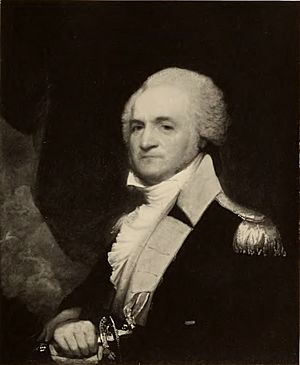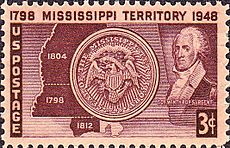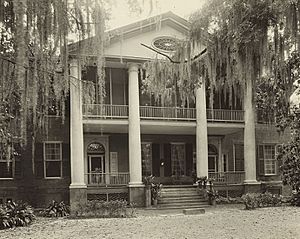Winthrop Sargent facts for kids
Quick facts for kids
Winthrop Sargent
|
|
|---|---|

portrait by Gilbert Stuart
|
|
| Governor of Mississippi Territory | |
| In office May 7, 1798 – May 25, 1801 |
|
| Preceded by | Position established |
| Succeeded by | William C. C. Claiborne |
| Secretary of Northwest Territory | |
| In office July 9, 1788 – May 31, 1798 |
|
| Preceded by | Position established |
| Succeeded by | William Henry Harrison |
| Adjutant General of the U. S. Army (Acting) |
|
| In office September 4, 1791 – November 4, 1791 |
|
| Preceded by | John Pratt (Acting) |
| Succeeded by | Ebenezer Denny (Acting) |
| Personal details | |
| Born | May 1, 1753 Gloucester, Massachusetts |
| Died | June 3, 1820 (aged 67) New Orleans, Louisiana |
| Political party | Federalist |
| Spouses |
Roewena Tupper
(m. 1789; Mary McIntosh Williams |
| Relations | Judith Sargent Murray (sister) Benjamin Tupper (father-in-law) Paul Dudley Sargent (uncle) |
| Parents | Winthrop Sargent Judith Saunders |
| Alma mater | Harvard College |
Winthrop Sargent (born May 1, 1753 – died June 3, 1820) was an important American figure. He was a soldier, a politician, and a writer. He was also a member of the Federalist Party, one of the first political parties in the United States.
Contents
Early Life and Education
Winthrop Sargent was born in Gloucester, Massachusetts, on May 1, 1753. He was one of eight children. His parents were Winthrop Sargent and Judith Saunders. His older sister, Judith Sargent Murray, became a famous writer.
Winthrop Sargent came from a well-known family. His grandfather, Epes Sargent, owned a lot of land in Gloucester. Winthrop graduated from Harvard College in 1771. After college, he worked at sea for a while. He was a captain on a merchant ship owned by his father.
Military Service and Early Career
Winthrop Sargent joined the army when the American Revolution began. He became a lieutenant in 1775. He was promoted to captain lieutenant later that year. He fought in many important battles, including the siege of Boston, Long Island, White Plains, and Trenton. He became a captain in 1777 and a major in 1783. He left the army later that year.
After the war, Sargent helped survey new lands. In 1786, he helped map the Seven Ranges. These were the first lands organized under a new law called the Land Ordinance of 1785. Because he knew a lot about these lands, he helped start the Ohio Company of Associates. He was also an important part of the Scioto Company.
Public Service
In 1787, Winthrop Sargent became the secretary of the Ohio Company. The Congress of the Confederation then chose him to be the first Secretary of the Northwest Territory. This was a very important job, second only to the governor. He started this role in 1788.
Sargent also served in the military while in this role. He was the acting Adjutant General of the U.S. Army for a short time in 1791. He was wounded twice during the Battle of the Wabash in November 1791. In 1796, as acting governor, he helped create Wayne County, Michigan. This was the first American government in what is now Michigan.
President John Adams appointed Sargent as the first Governor of the Mississippi Territory. He started this job on May 7, 1798. He arrived in Natchez in August but was sick. He officially began his duties on August 16. As governor, he helped set up the new government in the territory.
Later Life and Interests
In 1788, Sargent became a member of the American Academy of Arts and Sciences. He also joined the American Philosophical Society in 1789. He was an original member of the Society of the Cincinnati, a group for officers who fought in the Revolution. He also wrote some papers and a poem.
In 1801, Thomas Jefferson became president. Because Sargent was a Federalist, he was removed from his job as governor. He then focused on his private life. He developed his plantation called Gloucester in Natchez. In 1813, he was elected a member of the American Antiquarian Society.
Family Life
Winthrop Sargent was married three times. In 1789, he married Roewena Tupper in Marietta, Ohio. This was the first wedding held under the laws of the Northwest Territory. She passed away in 1790.
He then married Hannah Ober in 1791. They had a daughter named Hannah. Hannah Ober died the day after her daughter was born.
Later, he married Mary McIntosh Williams. They had three children:
- Caroline Augusta Sargent (1795–1844)
- William Fitz-Winthrop Sargent (born 1799)
- George Washington Sargent (1802–1864)
Winthrop Sargent died on June 3, 1820, in New Orleans. His grandson, also named Winthrop Sargent, became a writer.
Legacy
Some places might be named after Winthrop Sargent. There are Sargent Townships in Illinois and Nebraska, and a Sargent County in North Dakota. It is not known for sure if they are named after him. However, a former area in Michigan's Wayne County was called Sargent Township.
A student dormitory at Ohio University in Athens, Ohio, is named Sargent Hall in his honor. Ohio University was the first university in the Northwest Territory.



